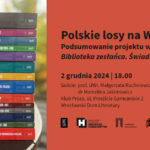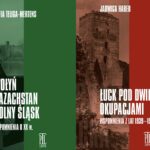See below for the English version.
Prezentowany tom zawiera relacje dwojga małżonków: Witolda (1897-1980) i Heleny Scheuring z domu Prugar (1907-1993). W. Scheuring był prawnikiem do wybuchu II wojny światowej pracował jako sędzia w Sądzie Okręgowym w Gnieźnie (województwo poznańskie). Tam też zamieszkiwali wraz z Heleną oraz synem urodzonym w 1934 r. Witold i Helena pochodzili ze Lwowa. Przeżycia odnotowywane na kartach ich wspomnień były oparte niejednokrotnie na doświadczeniach odmiennych co do charakteru. Witold we wrześniu 1939 r. służył w Wojsku Polskim. Uniknął niewoli i dotarł do Lwowa, gdzie spotkał się z Heleną. Wiosną 1940 r. został aresztowany, a następnie skazany i osadzony w obozie. Helena początek wojny przeżyła we Lwowie, a pozbawiona wolności niemal jednocześnie z mężem znalazła się w Kazachstanie, w realiach przymusowego osiedlenia. Przebywając tam do 1946 r. zarejestrowała różne fazy represji wskazanego typu. Można więc przyjąć, że relacje obojga są względem siebie komplementarne i oddają znaczną część z palety radzieckich działań skierowanych przeciwko obywatelom II RP: zatrzymania, aresztowania, procesy, osadzenia w więzieniach, zsyłki, dzielenie rodzin.
Tom oddawany do dyspozycji czytelników ma szczególny charakter ze względu na zestawienie go z relacji dwojga osób, które będąc małżeństwem poddane zostały radzieckim represjom niemal jednocześnie, ale w praktyce niezależnie. Ich losy splotły się w czasie II wojny światowej dwukrotnie, w okresach kilkumiesięcznych: we Lwowie od końca września 1939 r. do pierwszych dni kwietnia 1940 r. oraz od grudnia 1941 r. do marca 1942 r. Fragmenty relacji obojga, obejmujące te odcinki czasu, dają nieczęstą szansę porównania dwóch perspektyw na te same wydarzenia osób sobie najbliższych. Biorąc pod uwagę całość tomu, są to jednak fragmenty stanowiące jego zdecydowanie mniejszą część. W wypadku relacji obojga małżonków mamy do czynienia ze świadectwem przedstawicieli grupy, która do 1939 r. zaliczała się do warstwy elitarnej – ludzi dobrze wykształconych, budujących swoją egzystencję rodzinną w oparciu o dobrze płatne stanowisko w służbie państwowej.
W wypadku wspomnień i Witolda, i Heleny można wskazać na kilka zasadniczych wątków ich relacji. Wyraźnie wyodrębnioną część w świadectwie Witolda stanowi zapis dotyczący września 1939 r. Oddaje on realia pierwszych dni wojny w Gnieźnie, w tym okoliczności internowania miejscowych Niemców, a także bombardowanie miasta i jego skutki. Interesujące światło na realia zaplecza umownego frontu polsko-niemieckiego rzucają wzmianki rejestrujące kolejne etapy ewakuacji na wschód. Bardzo dobrze oddana została stopniowa destrukcja polskiego aparatu państwowego i dowódczego, w coraz mniejszym stopniu zdolnego do kierowania sytuacją na obszarze tyłowym, w tym zwłaszcza do organizowania i kanalizowania ewakuacji instytucji wojskowych oraz ruchu ludności cywilnej. Choć narracja pozbawiano jest tu ścisłych odniesień do chronologii, można tę ostatnią fragmentarycznie odtworzyć w odwołaniach na podstawie informacji o epizodach, których daty są znane (np. bombardowania Gniezna i Garwolina).
Realia okupacji radzieckiej od września 1939 r. do kwietnia 1940 r. stanowią kolejny wyróżniający się, duży fragment relacji obojga małżonków. Część autorstwa Witolda jest o tyle dodatkowo urozmaicona, że próbując się dostać ze Złoczowa do Lwowa w ostatniej dekadzie września 1939 r. mógł on obserwować pierwsze dni sowieckiej obecności na prowincji województw tarnopolskiego i lwowskiego. W efekcie wyłania się obraz daleki od jednoznaczności, a oceny autora odnośnie postaw czy to przedstawicieli mniejszości narodowych, czy nawet żołnierzy radzieckich nie są pozbawione ambiwalencji. Warto odnotować deklarację ówczesnego przekonania, że oto po 20 latach bolszewicy zmienili się, a ich zachowanie będzie miało bardziej cywilizowany charakter w zestawieniu z doświadczeniem wojny lat 1919-1920. Obraz pierwszych miesięcy okupowanego Lwowa nie jest pozbawiony pewnych stereotypowych elementów (nocne koszule jako podstawa uroczystego ubioru żon radzieckich urzędników i oficerów). Wiarygodność relacji jeśli chodzi rejestrowanie specyfiki życia codziennego i postępującą sowietyzację jest jednak zapewne wysoka, na co wskazuje trafne osadzenie w chronologii kolejnych regulacji władz okupacyjnych.
Świadectwo Witolda nie odnotowuje wszystkich etapów represji, jakim został poddany. Brak w nim części środkowej, która zawierałaby ostatni etap pobytu w więzieniach oraz opis podróży z Ukrainy do obozu umieszczonego na radzieckim Dalekim Wschodzie. Odtworzone zostały natomiast realia więzień: lwowskiego, kijowskiego i czernichowskiego. Fragmenty te wydają się bardzo cenne. Stanowią przyczynek do biografii osób pozbawionych wolności na skutek fali aresztowań jaka miała miejsce 9 kwietnia 1940. Dodać można, że oceny formułowane przez Autora pod adresem wówczas współosadzonych bywają niekiedy surowe. Ostatni fragment dotyczący fazy represji odnosi się do pobytu w obozie. Szczególnie ciekawy wydaje się opis przejściowego stanu, w jakim znaleźli się więzieni Polacy po podpisaniu układu Sikorski-Majski. Witold Scheuring rejestruje zarówno nastroje wśród nich, jak i postawy przedstawicieli radzieckich władz obozowych, postawionych w sytuacji dla siebie zapewne nader niewygodnej.
Relacja Heleny Schuring jest krótsza, aniżeli wspomnienia jej małżonka. W zasadniczej swojej części, poświęconej represjom radzieckim zawiera przede wszystkim spostrzeżenia związane z warunkami pobytu w Kazachstanie w latach 1940-1946. Jak sygnalizowano wyżej, pozwoliło to autorce na dosyć pełne – odnośnie okresu II wojny światowej – ujęcie problemu przymusowego osiedlenia Polaków w Kazachstanie. Zostały oświetlone wszystkie kluczowe fazy: pierwszy etap drogi na zsyłkę, realia zderzenia z kompletnie odmiennymi warunkami dnia codziennego, zmiany związane z układem polsko-radzieckim i pojawieniem się polskich instytucji pomocowych, konsekwencje zerwania stosunków dyplomatycznych w 1943 r. i przejmowanie roli formalnego opiekuna zesłańców przez agendy Związku Patriotów Polskich. Wspomnienia Heleny odnotowują zarówno wiele wariantów niełatwych często relacji pomiędzy Polakami, jak i wachlarz interakcji z obywatelami radzieckimi, tak Rosjanami jak i Kazachami. Szczególnym wyróżnikiem jej świadectwa jest opis nieudanej próby dotarcia z Kazachstanu do Lwowa jesienią 1940 r. Była to zapewne niezwykle rzadka sytuacja, ponieważ radzieckie wojska pograniczne nadal przegradzające terytorium USRR wzdłuż kordonu ryskiego w ciągu niemal całego 1940 r. zatrzymały zaledwie około 20 osób. Ponieważ w trakcie ucieczki Helenie Scheuring udało się dotrzeć niemal do granicy polsko-radzieckiej z 1921 r., miała ona szczególną okazję zaobserwować codzienność radziecką poza miejscem zesłania.
***
Witold Scheuring, Helena Prugar-Scheuring, From Lviv to the East. A story of a married couple’s wandering
This volume contains accounts of a married couple: Witold (1897-1980) and Helena Scheuring [née Prugar] (1907-1993). Witold was a lawyer and before WWII worked as a judge in the District Court in Gniezno (Poznań Province). He and Helena also lived in Gniezno and raised their son (born in 1934) there. They both came from Lviv. In their accounts they talk about their experiences, which more often than not are very different in nature. In September 1939, Witold served in the Polish Army. He managed to escape imprisonment and reached Lviv where he joined Helena. In the spring of 1940, he was arrested and then sentenced to imprisonment in a forced-labour camp. Helena spent the beginning of the war in Lviv. Imprisoned roughly at the same time as her husband, she came to live in Kazakhstan, and was forced to settle there. Until 1946, Helena recorded various stages of repressions of different kinds. Thus, it can be assumed that Witold’s and Helena’s accounts are mutually complementary and render a great part of the wide scope of Soviet repressions against the citizens of the Second Polish Republic: detentions, arrests, lawsuits, imprisonment, deportations, separation of families.
Readers will find this publication quite special, as it comprises accounts of two people, a married couple, who almost simultaneously, and yet – practically independently from one another – became subject to Soviet repression. During WWII their paths crossed twice, for a few months: in Lviv, from the end of September 1939 till the first days of April 1940, and from December 1941 till March 1942. Fragments of both their accounts talking about those periods of time give a rare chance to compare two perspectives on the same events by two closest people. However, considered in the context of the whole publication, these fragments definitely constitute a smaller part of it. In the case of both Witold and Helena, we can talk about people who before WWII were part of a well-educated elite who based their family existence on a highly-paid positions in the state service.
Analysing both Witold’s and Helena’s narratives, we can identify a few main topics. In Witold’s account, a particularly prominent part is devoted to the events of September 1939. It renders the reality of the first day of war in Gniezno, including the circumstances of interning the local Germans, as well as bombing the city and its consequences. An interesting light on the reality of the rear of the customary Polish-German front is shed by the recollections of the subsequent stages of evacuation to the East. The account gives a very detailed picture of the gradual destruction of the Polish state and command apparatus, which is less and less able to manage the situation in the rear area, and in particular to organize and channel the evacuation of military institutions and flow of civilian population. Even though the narrative lacks strictly chronological references, we are able to partially reconstruct its order on the basis of information about events the dates of which we know (such as bombarding Gniezno and Garwolin).
Another big and significant parts of the accounts of both spouses are devoted to the reality of the Soviet occupation between September 1939 and April 1940. What adds variety to Witold’s story is that, trying to get from Zolochiv to Lviv in the last decade of September 1939, he could watch the first days of the Soviet presence in the provinces of Tarnopol and Lviv. As a result, we get a picture which is far from clear-cut, and the author’s assessment of the attitudes either of national minorities or even Soviet soldiers are not free from ambivalence. It is worth noticing that the author declares he is convinced that after 20 years the Bolsheviks have changed, and that they will behave in a more civilised way as compared to the experiences of the war of 1919-20. The Lviv of the first months under occupation is presented not without certain stereotypical aspects (nightdresses as the basis for a chic outfit worn by wives of Soviet officials and officers). Still, credibility of the reports describing the everyday life and advancing Sovietization must be quite high, as indicated by the correct chronological order of successive rules and regulations issued by the occupant.
Witold’s account does not register all phases of repressions he was subjected to. The middle part is missing – that is, the part telling about the last stages of his imprisonment and his travel from Ukraine to a labour camp in the Soviet Far East. However, a description of the Lviv, Kyiv and Chernihiv prisons is given. These fragments of the text seem to be of great value. They make a contribution to biographies of people imprisoned following a wave of arrests which took place on April 9, 1940. It can be also mentioned that the author’s opinions on his fellow inmates can be quite low. The last fragments describing the phase of repressions talks about the time Witold spent in the forced-labour camp. What seems particularly interesting is the depiction of the transitory state many imprisoned Poles found themselves in after the Sikorski-Mayski agreement was signed. Witold Scheuring recounts both their mood, as well as attitudes existing among the representatives of the Soviet camp authorities – who were left in an extremely inconvenient situation.
The account given by Helena is shorter than her husband’s. The majority of it is devoted to Soviet repressions and contains mostly insights into conditions of living in Kazakhstan in the years 1940-1946. As it has already been mentioned, the author had an opportunity to quite thoroughly – in regard to the time of WWII – describe the problem of forced resettlements of Poles to Kazakhstan. She discusses all the key issues: the first stage of being sent into exile, the confrontation with completely different everyday living conditions, changes related to the Polish-Soviet arrangements and introduction of Polish aid organizations, the consequences of breaking off diplomatic relations in 1943, and taking over the role of the formal guardian of the exiles by the agencies of the Union of Polish Patriots. Helena’s account presents not only many types of – quite often difficult – relations among Poles, but also an array of interactions with Soviet citizens, both Russians and Kazakhs alike. A characteristic part of her narrative is a description of a failed attempt at reaching Lviv from Kazakhstan in the autumn of 1940. It must have been a rather unusual situation, because the Soviet border forces still stationed in the Ukrainian SSR along the Riga cordon detained only about 20 people during the almost entire 1940. Since during her escape Helena Scheuring managed to get almost to the very Polish-Soviet border of 1921, she had an unparalleled opportunity to observe the Soviet everyday life outside her place of exile.






Comments by admin